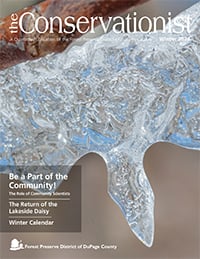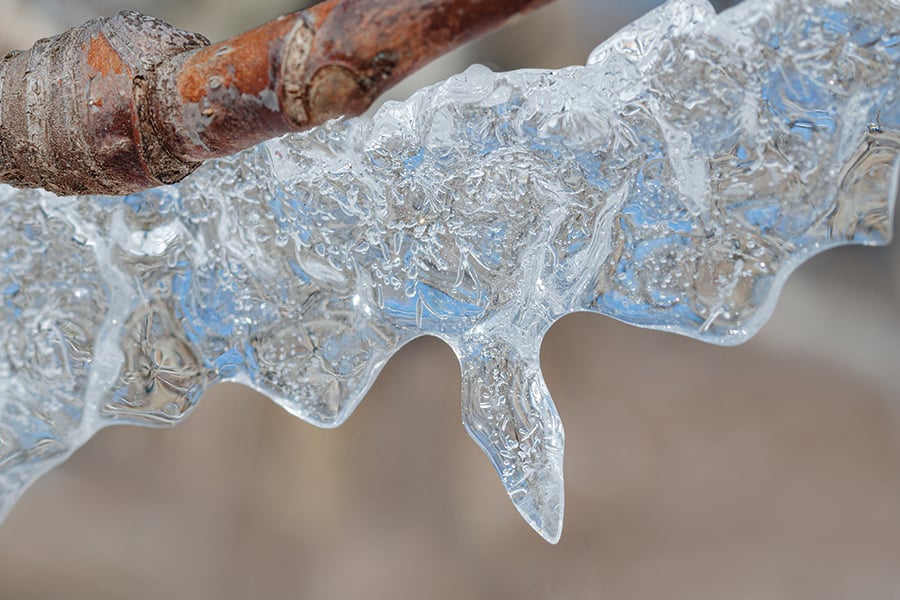
Conservationist Winter 2024
From the President

Hello and Happy New Year! And what a year 2024 is going to be here at the Forest Preserve District.
In 2019 the Board of Commissioners approved a five-year Districtwide master plan containing 32 certified projects and 15 initiatives. To date, we’ve completed 16 projects from that list including the restoration of the historic 1870s bridge at Hidden Lake, a new 180-car parking lot at Waterfall Glen, and major exterior renovations at Mayslake Hall. (Join us this spring as we officially mark this particular accomplishment with a grand reopening of the historic site.)
Now in 2024, we’re working on checking off even more from the list. For visitors’ comfort we’re adding ADA-accessible family flush restrooms at Wood Dale Grove, Pratt’s Wayne Woods, Waterfall Glen, and Mallard Lake. And true to our mission, we’re restoring habitat throughout the District, including making progress on 550 acres of wetland, prairie, and savanna at Herrick Lake, the largest single contiguous restoration project in the Forest Preserve District’s history.
With our newly reorganized website, you can keep tabs on the progress of these projects and more. You will find links to all of our projects, which you can sort by planned, in progress, and completed.
All the best in 2024, and I’ll see you on the trails!
Daniel Hebreard
President, Forest Preserve District of DuPage County
News & Notes
Stay in the Know
Sign up for text alerts to get the latest on important updates and new programs. Text any of our keywords from ARCHERY to WILDLIFE (one keyword per text) to 866-743-7332 to begin receiving alerts. You can opt out at any time. (Message and data rates may apply.) For details, including a full list of keywords, visit “Text Alerts.”

Grant to Benefit Willowbrook Wildlife Center
The Forest Preserve District has received a $250,000 grant from the Museums for America program of the Institute of Museum and Library Services to support the visitor experience at Willowbrook Wildlife Center.
This project is part of extensive improvements at the site, which include a new state-of-the-art clinic and visitor center. The grant will support the creation of indoor and outdoor interpretive exhibits and panels at the center and along the outdoor trails. It will also include the development of curriculum for guided and self-guided school field trips; the creation of a classroom loan box and lesson plans; and the development of a family discovery backpack for on-site use.
Collections Corner
This time of year, St. James Farm is busy welcoming riders either renting the indoor arena or participating in “Obstacle Course Play Dates,” and this flurry of equestrian activity makes it a great time to talk tack! (That’s the saddles, bridles, and other equipment horseback riders regularly use.)
In the 1980s and 1990s, the farm’s previous owners hosted steeplechase races, dressage, cross country, and show jumping events. As a result, the Forest Preserve District today has several vintage saddles in its collection, including two Champion & Wilton English sidesaddles, one from 1930 and one from 1935 (shown below). Sidesaddles date back to the 14th century and were an easier way for women in heavy skirts to ride, especially, as was perceived for decades, in a “modest fashion.” Marion Deering McCormick of St. James Farm (1886 – 1965) used one for hunting and other riding.
Riders today still use saddles from this era, but the ones at St. James Farm are no longer in use. You can see them, though, on display at the indoor arena January – March. Call 630-580-7025 for hours.

Forest Preserve District Intentionally Works in the Dark
The Forest Preserve District realizes the harmful effects of light pollution — unwanted or excessive artificial light — and takes its mandate to protect nature seriously. Scientific research shows that artificial night lighting has negative effects on a variety of species, including amphibians, birds, mammals, insects, and plants.
Of the 26,000 acres of land managed by the Forest Preserve District, only 125.6 acres, or 0.4%, are currently affected by Forest Preserve District-emitted lighting. For instance, at Pratt’s Wayne Woods in Wayne and Springbrook Prairie in Naperville, spanning 3,441 and 1,824 acres respectively, only 1 acre at each is affected. But the Forest Preserve District wants to do better.
The agency is conducting a comprehensive exterior audit to eliminate any unnecessary lighting altogether and to identify additional opportunities for improvements. Of course, the safety of forest preserve visitors and staff is paramount, which is why its Facilities Management department is working closely with its Law Enforcement staff to take a thoughtful approach to the placement of fixtures, motion sensors, timers, manual switches, and other technologies.

Annual Permits on Sale
Annual permits for 2024 for private boating, archery, off-leash dog areas, and model crafts are now on sale at dupageforest.org.
Permits are also available Monday – Friday 8 a.m. – 4 p.m. through Visitor Services at 630-933-7248 or at Forest Preserve District headquarters at 3S580 Naperville Road in Wheaton.
Questions? Call Visitor Services, or use our convenient online chat.

Thank You for Being a Friend
The Friends of the Forest Preserve District of DuPage County is a 501(c)(3) organization engaging the community in philanthropy to advance the mission and purpose of the Forest Preserve District. We are grateful to recognize those who donated $500 or more during the third quarter to the Friends or directly to the Forest Preserve District.
Friends of the Forest Preserve District invites contributions to meet the greatest needs in our forest preserves and to support master plan projects. Currently, Friends has a focus on inviting gifts for the new Willowbrook Wildlife Center, an ambitious project that advances wildlife care, public engagement, and sustainability. For details, contact Partnership & Philanthropy at fundraising@dupageforest.org or 630-871-6400. To donate, visit dupageforest.org/friends or mail a check payable to the Friends of the Forest Preserve District of DuPage County to 3S580 Naperville Road, Wheaton, IL 60189.
Gifts of $25,000 or More
The Diane E. Langley Declaration of Trust
Gifts of $10,000 – $24,999
Anonymous
Gifts of $5,000 – $9,999
The Conservation Foundation on behalf of the West Chicago Prairie Stewardship Group
Myriam Villalta Elijah
Nicor Gas
Gifts of $1,000 – $4,900
The Casten Family
The Grisemer Family Charitable Trust
Susan Johansen
Jennifer Pope and Leo Schwarz
PowerForward DuPage
The Richard Laurence Parish Foundation
Jennifer Stitzell
Theosophical Order of Service
Gifts of $500 – $999
Patricia Gabris
Milton Township
Wheaton Lions Club
Be a Part of the Community!
This new year, as you explore your favorite forest preserves, take a few moments to join the millions of people across the globe engaging in community science!
Community scientists have expanded the scope of discovery in the preserves by helping professional scientists collect large amounts of data, information researchers may not be able to gather otherwise. Participating in community science is a meaningful way to spend time outdoors, explore the forest preserves, and connect with nature while building a deeper appreciation of local plants and wildlife. And anyone can do it! It can be a fun family activity, a way to get students involved in project-based learning, or a chance for individuals to make a real contribution to real science.
You can join many community science projects simply by taking a picture and uploading it to an app like iNaturalist, eBird, or Budburst or a site like Journey North. With each, people can share what they’ve seen and where they’ve seen it and then have other contributors verify their findings.
For example, the Forest Preserve District maintains an iNaturalist project page that catalogs all the different organisms found within the boundaries of DuPage County’s forest preserves. Preserve visitors snap pictures of plants and animals, usually with their phones, and upload them to the site. If they can’t ID an image, the app will give it a shot. The “iNat” community then weighs in to positively identify subjects, making observations “research-grade” and valuable to professional scientists working to better understand and protect nature. To date, over 31,000 research-grade observations of over 3,600 different species have been added to the Forest Preserve District project. Some of the most common species observed are the red-tailed hawk, prairie trillium, common milkweed, and white-tailed deer, but community scientists occasionally add rare entries to the list.
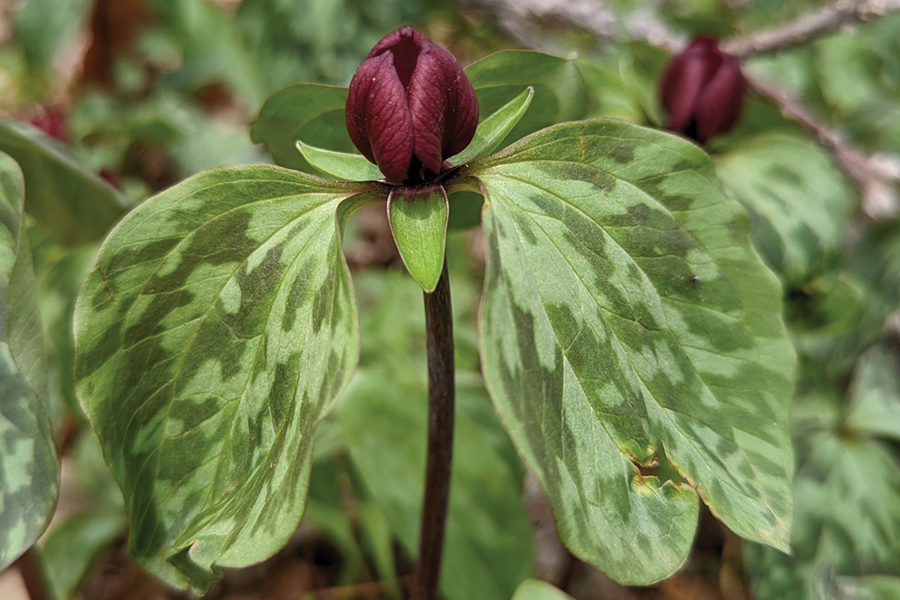
Prairie trillium
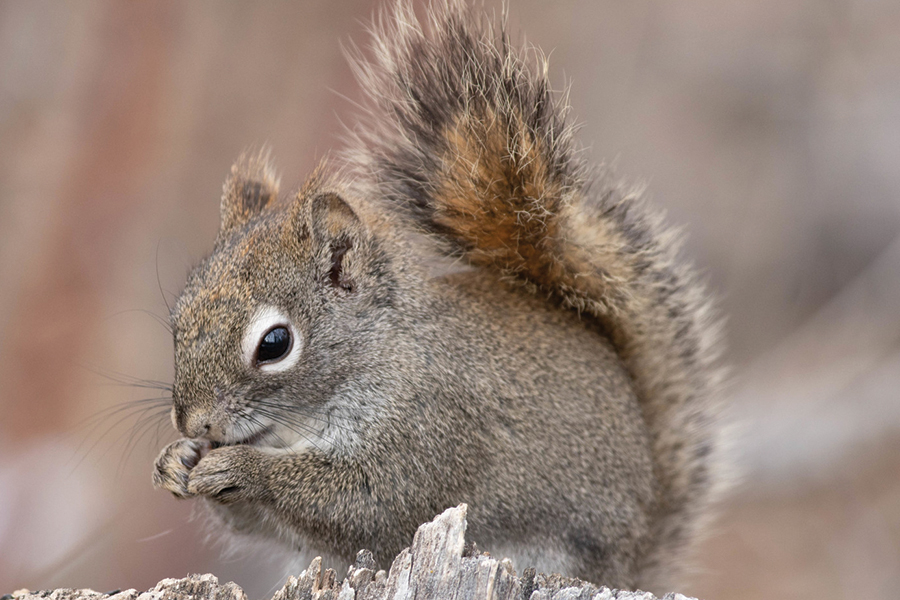
American red squirrel
In 2020, a visitor photographed an American red squirrel at Waterfall Glen, the first record of the species in a DuPage preserve. (Unlike fox and gray squirrels, from the top of the head to the tip of the tail, a red squirrel is only about 12 inches long.) A community scientist verified the discovery by adding his own geotagged red squirrel photograph to iNaturalist in winter 2023. This made the record research-grade and gave professional scientists a better understanding of how the small squirrel is expanding its range in the Chicagoland area.
In October 2023, a community scientist using iNaturalist documented a limpkin at Fullersburg Woods, the first recorded sighting in DuPage. Birdwatchers from across the region flocked to the forest preserve to watch the rare wading bird forage for snails in Salt Creek. Many of those birdwatchers also used the eBird app to add the limpkin to their personal checklists. Beyond helping people remember what they observed, eBird checklists also create large datasets that professional scientists at the Cornell Lab of Ornithology analyze to develop range maps, migration projections, and population trends.
But community science isn’t just for grown-ups. In April 2022, elementary school students visiting Fullersburg Woods for a field trip used iNaturalist to help them identify bugs. Their picture of a soil centipede turned out to be the first record of the species Strigamia bothriopus in Illinois!
Some sightings are less celebrated but just as important. Projects on iNaturalist, for instance, are marking the spread of the invasive spotted lanternfly by verifying community scientists’ observations as research-grade, helping entomologists monitor how fast this invasive species is spreading. To date, this insect has not been identified in DuPage County, but its arrival is not ruled out.
At the Forest Preserve District, people can take community science to the next level by becoming volunteer monitors. District ecologists provide basic training prior to each monitoring season and can use the data monitors collect to make informed habitat management decisions.
Volunteer bird monitors, for instance, listen and look for birds off-trail during the breeding season. This can help Natural Resources crews know when to mow or use prescription fires without disturbing nesting species. Dragonfly and butterfly monitors learn how to identify and record different species so the District can see how populations respond to habitat changes. And rare plant and fungi monitors keep tabs on individual specimens of interest. For details on all monitoring programs, visit dupageforest.org/get-involved/volunteer and scroll down to Natural Resources.
This winter while you’re exploring the forest preserves, looking for wildlife, discovering plants, or taking photographs, consider how your observations can contribute to conservation science. You just might make the next important nature discovery!
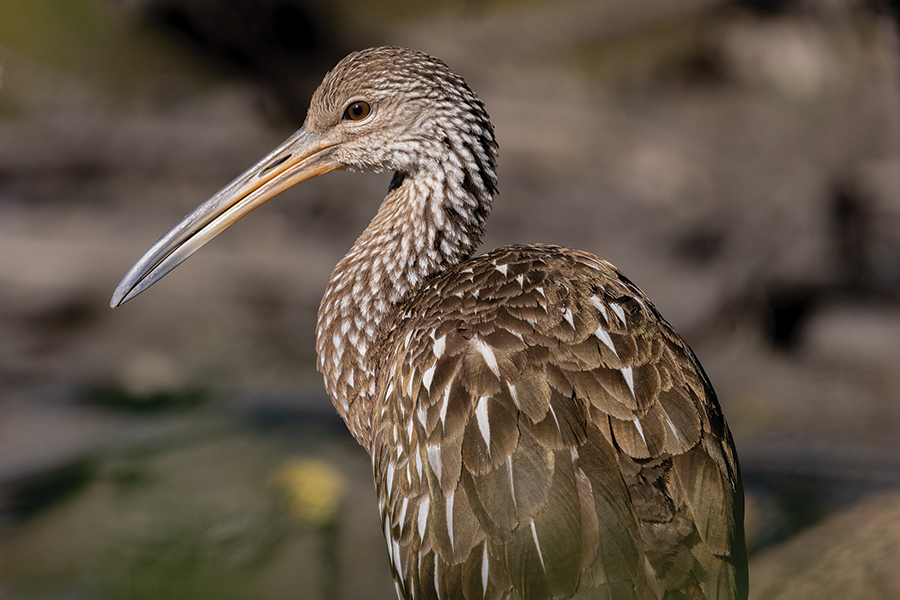
limpkin
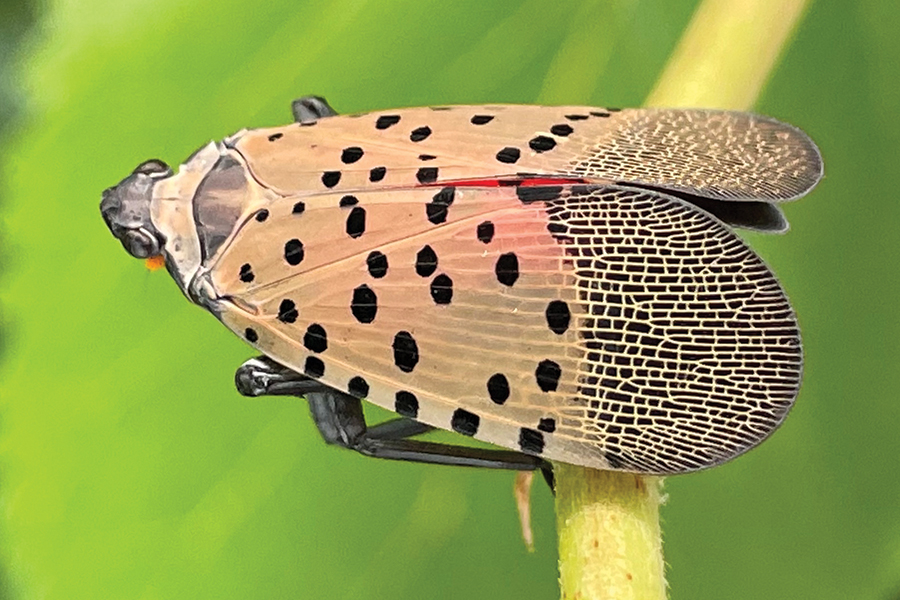
Spotted lanternfly
The Return of the Lakeside Daisy
Sometimes the smallest of gems in a DuPage forest preserve needs a network of conservation agencies to thrive.
The lakeside daisy is a long-lived 4-to-12-inch-tall perennial in the aster family that grows in full sun in “alvar” habitats, gravelly areas with shallow soils where few other species can survive. (It may pop up occasionally in other habitats but is eventually overtaken by other plants.) Its dark green leaves are covered in white hairs and grow in a basal rosette, a circular array around the base of the plant. Atop each leafless stem is a single bright yellow flower head that blooms between late spring and early summer, its petals lasting only a week before fading and later dropping. Flowers in a community usually open at the same time. This likely increases the chance of pollination by bees, butterflies, flies, beetles, skippers, and other insects, but it also creates a carpet of gold on an otherwise barren-looking landscape. Throughout the day these vibrant blooms slowly turn in unison so they’re always facing the sun.
But the lakeside daisy is quite rare. In fact, it’s endangered in Illinois and federally listed as threatened by the U. S. Fish and Wildlife Service. It’s considered endemic to the Great Lakes, meaning that globally, it only grows in the Great Lakes region. Northern Ohio, northern Illinois, Michigan’s Upper Peninsula, and Ontario, Canada, are its only homes, and even in those areas populations are sparse. Gravel mining and foot traffic are likely reasons suitable habitat has dwindled.
Unfortunately, this daisy has to deal with reproductive challenges as well as a loss of habitat. Although a new individual plant may sprout from the underground network of stems of an existing one, lakeside daisies primarily spread via seeds. The species is self-incompatible, though, which means to successfully produce seeds, a plant needs to be pollinated by not only another lakeside daisy but also a lakeside daisy that’s genetically different. When populations shrink and become more isolated, the probability that plants are genetically related is high. Even if there’s the right habitat, if there’s no flow of new genes into a population, lakeside daisies will not produce viable seeds — and eventually plants — and the entire population will die out.
At one point, the lakeside daisy was gone from the wild in Illinois, but in the late 1980s conservationists who had saved plants and seeds from other native areas were able to re-introduce the species in four counties to aid in the flower’s recovery. But over time the vast majority of these populations either died out or significantly declined due in part to long-term habitat changes.
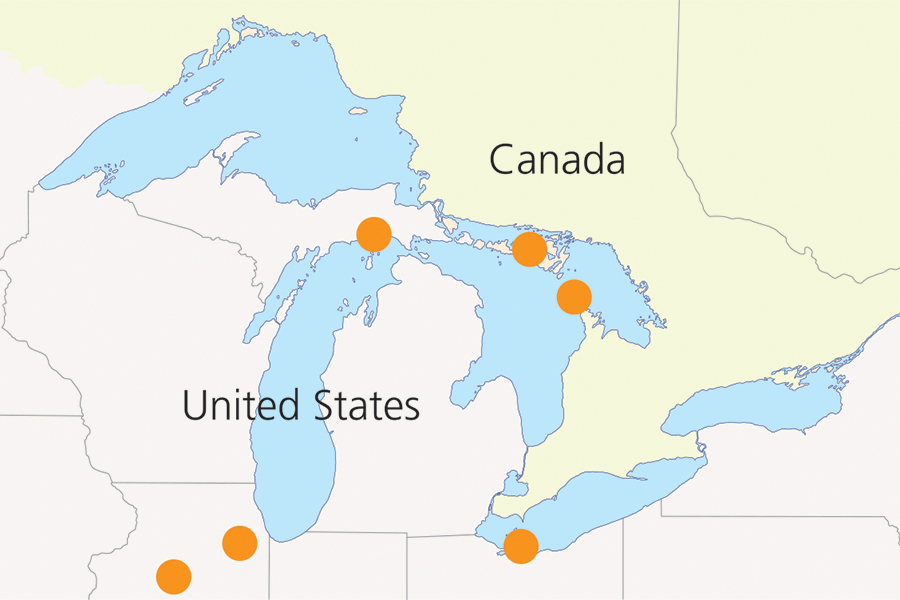
Worldwide, the plant’s dispersal is limited to a few parts of the Great Lakes region.
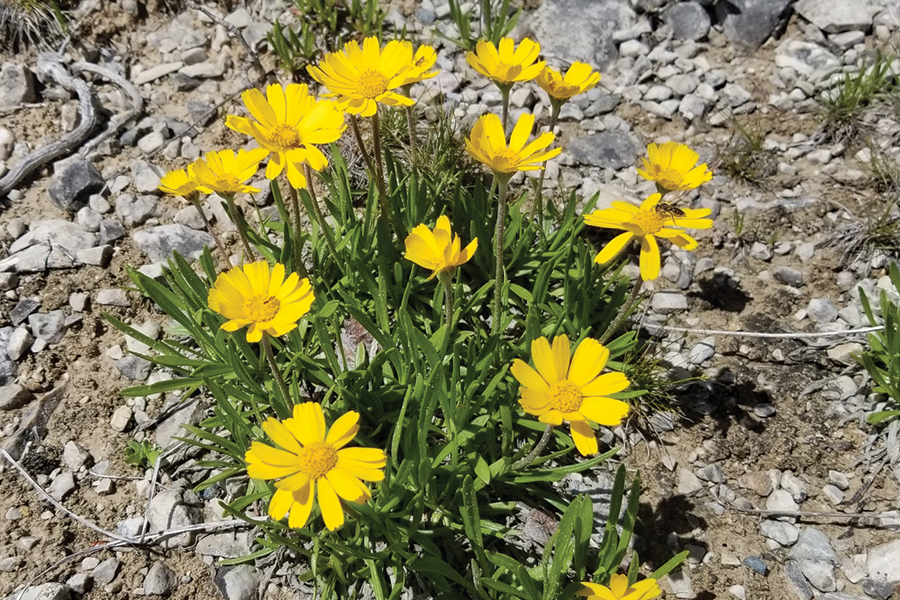
Lakeside daisies only grow in gravelly shallow soils.
In DuPage, the Forest Preserve District received plants grown by the Forest Preserve District of Will County. Seeds from that population were then taken to a second location in the early 2000s. By 2021, when ecologists conducted a statewide survey of the plant, the population in DuPage County was labeled “critically significant” and deemed the largest in Illinois.
But even though the population was large, there were some concerns. First of all, the plants were growing in an area that was predominantly clay, not gravelly like the daisy requires. Additionally, the plants were from the same seed source, so there was little genetic variation. Despite the fact that the plants were doing well at the time, ecologists feared they would eventually die out if no action was taken.
With this information the Forest Preserve District decided to ensure that this critical population survived and flourished. First, in an area near the existing population crews added gravel in the right size and shape for plants to grow. After that, the Chicago Botanic Garden joined the effort. The garden had been growing lakeside daisies as part of a study on the species and contacted the Forest Preserve District to place plants from the study in the preserve. Working with the Chicago Botanic Garden and the U.S. Fish and Wildlife Service, the District placed over 100 plants into the newly created gravel habitat. Because many of these plants have a different genetic background than the ones initially at the site, this will help strengthen the genetic diversity of the population.
With authorization from the Ohio office of the U. S. Fish and Wildlife Service, the Forest Preserve District also sowed seeds collected from Ohio. (Ohio has the largest natural population of lakeside daisies in the U.S.) Seeds planted in April 2023 germinated in mid-July, aided by the much-needed summer rains that followed the drought the area experienced earlier in the year. As expected, these seedlings have taken root better in the newly created gravel habitat than in the clayey areas where the original plants grew.
The work is not over, though. To protect the new plantings, the Forest Preserve District is working to control invasive species and aggressive native species, such as Indian grass, that can shade out or outcompete the daisies and provide fuel for fires that would be detrimental to the flowers’ survival.
Because not enough suitable habitat remains in Illinois, the lakeside daisy is likely to remain state-endangered. The DuPage population is able to thrive due to the dedicated stewardship of Forest Preserve District staff and outreach and cooperative efforts with other conservation agencies and organizations.
This is a conservation and endangered species success story that fulfills the mission of the Forest Preserve District and creates a living legacy we can all be proud of.

Forest Preserve District crews prepare a planting site for a patch of lakeside daisies.
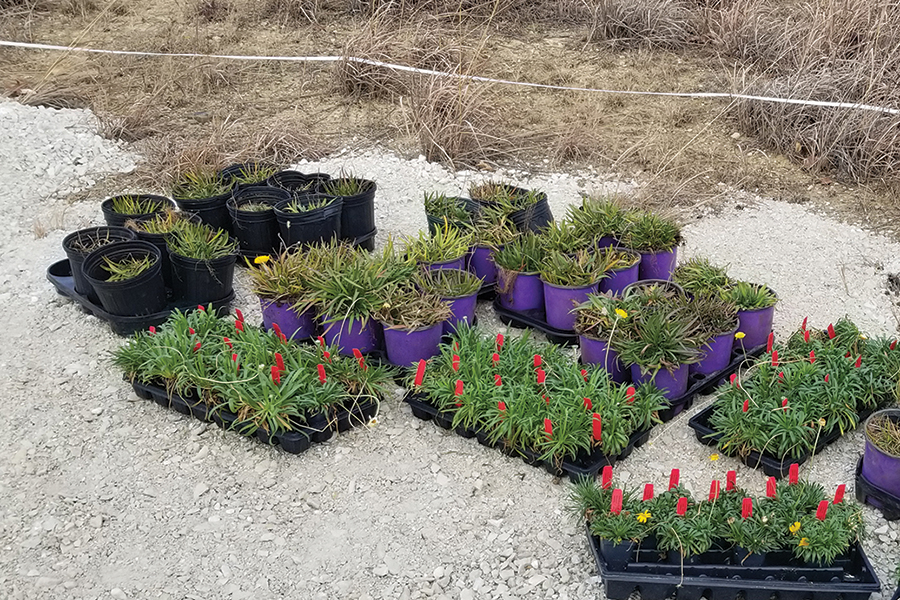
Ecologists use preserved seeds as well as plants grown from those seeds to augment existing colonies.
